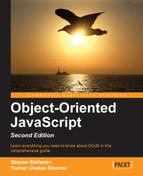If you find yourself using an if condition and having too many else if parts, you could consider changing the if to a switch:
var a = '1',
result = '';
switch (a) {
case 1:
result = 'Number 1';
break;
case '1':
result = 'String 1';
break;
default:
result = 'I don't know';
break;
}The result after executing this is "String 1". Let's see what the parts of a switch are:
- The
switchstatement. - An expression in parentheses. The expression most often contains a variable, but can be anything that returns a value.
- A number of
caseblocks enclosed in curly brackets. - Each
casestatement is followed by an expression. The result of the expression is compared to the expression found after theswitchstatement. If the result of the comparison istrue, the code that follows the colon after the case is executed. - There is an optional
breakstatement to signal the end of thecaseblock. If thisbreakstatement is reached, theswitchis all done. Otherwise, if thebreakis missing, the program execution enters the nextcaseblock. - There's an optional default case marked with the
defaultstatement and followed by a block of code. The default case is executed if none of the previous cases evaluated totrue.
In other words, the step-by-step procedure for executing a switch statement is as follows:
- Evaluate the
switchexpression found in parentheses; remember it. - Move to the first
caseand compare its value with the one from step 1. - If the comparison in step 2 returns
true, execute the code in thecaseblock. - After the case block is executed, if there's a
breakstatement at the end of it, exit the switch. - If there's no
breakor step 2 returnedfalse, move on to the nextcaseblock. - Repeat steps 2 to 5.
- If you are still here (no exit in step 4), execute the code following the
defaultstatement.
Tip
Best practice tips
- Indent the code that follows the
caselines. You can also indentcasefrom theswitch, but that doesn't give you much in terms of readability. - Don't forget to
break. - Sometimes, you may want to omit the
breakintentionally, but that's rare. It's called a fall-through and should always be documented because it may look like an accidental omission. On the other hand, sometimes you may want to omit the whole code block following acaseand have two cases sharing the same code. This is fine, but doesn't change the rule that if there's code that follows acasestatement, this code should end with abreak. In terms of indentation, aligning thebreakwith thecaseor with the code inside the case is a personal preference; again, being consistent is what matters. - Use the
defaultcase. This helps you make sure you always have a meaningful result after theswitchstatement, even if none of the cases matches the value being switched.
..................Content has been hidden....................
You can't read the all page of ebook, please click here login for view all page.
